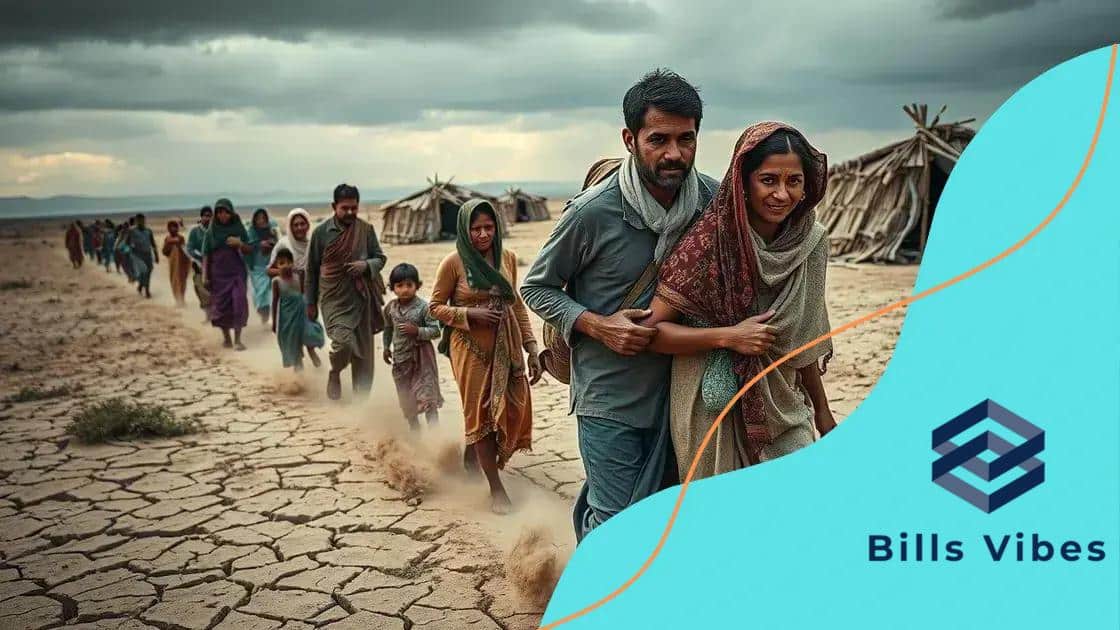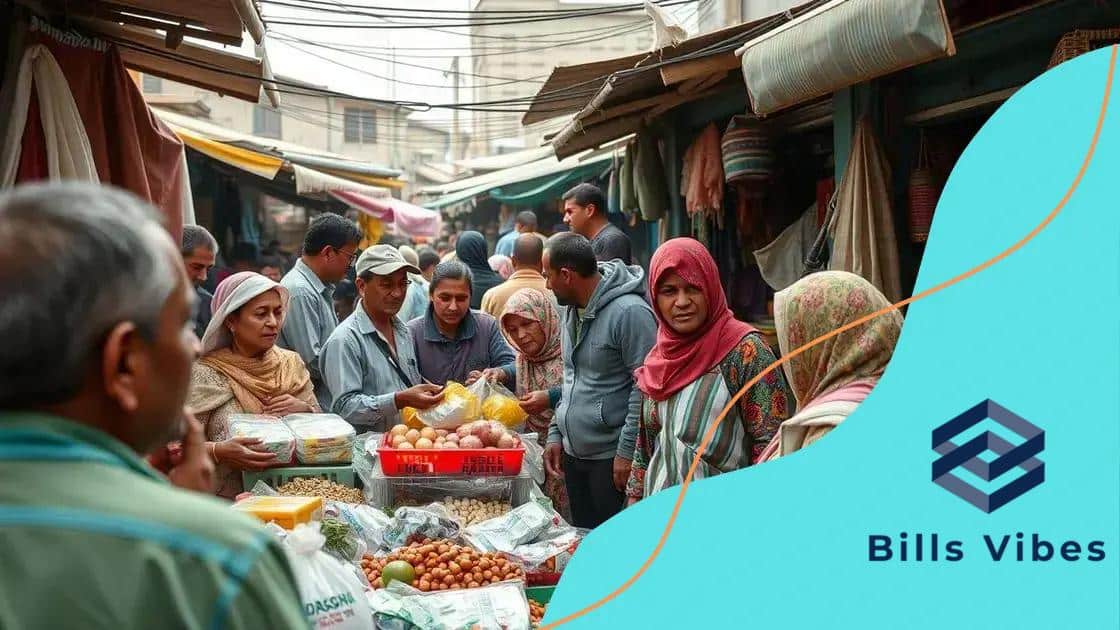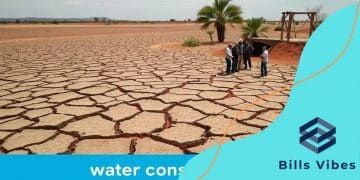Climate migration grows: understanding its impact

Climate migration is the movement of people caused by environmental factors, such as extreme weather events and resource depletion, requiring effective policies and community support to address its impacts.
Climate migration grows as an urgent dilemma, reshaping lives and communities. Have you considered how climate change is forcing people to relocate? This article dives deep into the causes and effects of this global phenomenon.
Defining climate migration
Defining climate migration is essential for understanding its implications. It refers to the movement of people caused by sudden or gradual changes in the environment. These changes often stem from extreme weather events, sea-level rise, or degraded land. Many individuals and families are forced to leave their homes in search of safety and stability.
This phenomenon involves complex socio-economic factors. It is not just about where people go, but also about why they leave. Economic hardship, food and water scarcity, and instability amplify the urgency of climate migration.
Key Factors Influencing Climate Migration
- Natural Disasters: Hurricanes, floods, and wildfires can displace entire communities rapidly.
- Gradual Environmental Change: Slow-onset events like desertification force people to move over time.
- Resource Scarcity: Lack of clean water or arable land drives individuals away from their homes.
- Political Stability: In areas where climate impacts worsen, governance can become unstable, prompting migration.
Though climate migration might sound straightforward, its effects ripple through societies. Families may separate, and cultural identities are at risk of disappearing. Moreover, migrants often face legal challenges and discrimination in new locations. The process can be heartbreaking as they leave beloved communities behind.
Understanding who migrates and why is crucial for policymakers. It enables them to create effective support systems for those affected. As the world continues to grapple with climate change, defining climate migration becomes increasingly important.
Causes and drivers of climate migration
The causes and drivers of climate migration are complex and varied. Primarily, they stem from environmental changes that force individuals to seek safer locations. Extreme weather events, such as hurricanes or floods, can occur suddenly, displacing thousands within a short time frame.
Beyond natural disasters, there are gradual changes that affect livelihoods and living conditions. For instance, rising temperatures lead to droughts and reduced crop yields, pushing people away from farming regions. This slow deterioration can be just as powerful in prompting migration.
Key Drivers of Climate Migration
- Natural Disasters: Hurricanes and earthquakes can devastate communities, leading to immediate evacuations.
- Resource Depletion: Scarcity of water and arable land forces families to relocate to find resources.
- Economic Instability: When agricultural production fails, economic hardships rise, pushing individuals toward urban areas or other countries.
- Health Risks: Poor air quality and disease outbreaks linked to environmental changes can threaten public health and drive migration.
Additional factors like government policies and social networks can also influence migration trends. Communities may feel compelled to move due to the failure of local governance to assist during crises. Meanwhile, social networks often play a role in choosing destinations for migrants, as they seek to be near family or established communities.
As climate change continues, understanding these causes becomes vital. The interplay of social, economic, and environmental factors will shape the future of climate migration, impacting millions across the globe.
Impacts on communities and economies

The impacts on communities and economies due to climate migration are profound and multifaceted. When people are forced to leave their homes, the social fabric of their communities is disrupted. Families and friends are separated, leading to emotional strain and loss of support networks.
In economic terms, climate migration can have varied effects. As individuals move, local economies may lose workers and consumers. This loss can depress local businesses and lead to reduced economic activity. In contrast, areas receiving migrants may experience workforce growth, which can spur economic development if managed well.
Effects on Communities
- Community Fragmentation: The migration of individuals can lead to the disintegration of established social networks.
- Increased Tension: Host communities may feel overwhelmed, creating friction between migrants and locals.
- Cultural Exchange: Newcomers can introduce diverse cultures, enriching the local community experience.
- Access to Resources: Crowded areas may struggle to provide adequate health care, education, and housing for all residents.
The influx of climate migrants can strain resources in receiving areas, particularly in cities where infrastructure is already taxed. These communities must adapt quickly to accommodate the increasing population. In addition, the demand for housing can increase, leading to rising prices and potential homelessness.
Despite the challenges, there are opportunities for positive change. Climate migrants can bring new skills and perspectives to their new locations. By contributing to the economy and enhancing cultural diversity, they can help revitalize struggling areas. Addressing the impacts of climate migration requires deliberate planning and collaboration among governments, organizations, and communities.
Policy responses to climate migration
Policy responses to climate migration are crucial for addressing the challenges it presents. Governments and organizations are beginning to recognize the need for comprehensive strategies to manage migration caused by climate change. These policies aim to protect vulnerable populations and ensure sustainable development.
Effective policies can take many forms, from legal frameworks to community support initiatives. Countries must collaborate to address the root causes of climate migration. This includes tackling climate change itself through mitigation and adaptation strategies.
Key Policy Approaches
- Recognition of Climate Migrants: Legal frameworks that acknowledge climate migrants can lead to better protection and assistance.
- Investment in Resilience: Funding for infrastructure, housing, and public services in high-risk areas can help communities adapt.
- Cross-Border Cooperation: Countries sharing migration pathways can work together to create shared responses and support systems.
- Educational Programs: Providing education and skills training for migrants can help them integrate into new communities more smoothly.
Creating successful policies requires input from various stakeholders, including local communities, NGOs, and international organizations. Engaging these groups ensures that responses are culturally sensitive and effective. It is also essential to anticipate future migration trends, as climate change will continue to affect populations worldwide.
Moreover, policies should not just react to migration but also proactively seek to reduce the factors that cause it. Investments in green technologies, sustainable farming, and renewable energy can help stabilize communities. By addressing these concerns strategically, societies can better manage the impacts of climate migration and foster more resilient environments.
Future trends and challenges
Future trends and challenges related to climate migration present significant factors that will shape how societies adapt to changing conditions. As the impacts of climate change intensify, we can expect to see an increase in the number of climate migrants worldwide. This trend will necessitate stronger policies and collective action from governments and organizations.
One of the major challenges is predicting migration patterns. Understanding where and when people will move helps governments prepare and allocate resources effectively. Increased data collection and analysis will be critical in anticipating these trends.
Emerging Trends in Climate Migration
- Urbanization: Many migrants are moving to cities, creating challenges in urban planning and infrastructure.
- Climate Resilient Communities: There is a push for developing communities that can withstand environmental stress rather than migrate.
- Policy Innovation: New frameworks will be necessary to address the legal status and rights of climate migrants.
- Regional Cooperation: Countries will need to collaborate on solutions to mitigate the impacts of climate migration.
Communities that receive migrants will face unique challenges. They must manage increased demands on housing, healthcare, and education systems. This requires careful planning and investment in local infrastructure to accommodate growth. As climate conditions evolve, the social dynamics between migrants and locals may shift, requiring ongoing dialogue and community engagement.
Moreover, climate change is not just about immediate impacts; its long-term effects on agriculture and local economies could create cyclical patterns of migration. Understanding these cycles will be essential for developing sustainable support systems. Advocacy for migrant rights will also become increasingly vital, ensuring those affected have a voice in the policies that shape their futures.
FAQ – Frequently Asked Questions about Climate Migration
What is climate migration?
Climate migration refers to the movement of people forced to leave their homes due to drastic environmental changes, such as natural disasters or gradual climate shifts.
What are the main causes of climate migration?
The main causes include extreme weather events, resource depletion, sea-level rise, and deteriorating living conditions due to climate change.
How do communities respond to climate migration?
Communities can respond by developing supportive policies, enhancing infrastructure, and fostering integration programs for migrants.
What challenges do migrants face in new communities?
Migrants often face challenges such as discrimination, limited access to resources, housing shortages, and the struggle to establish new social networks.






